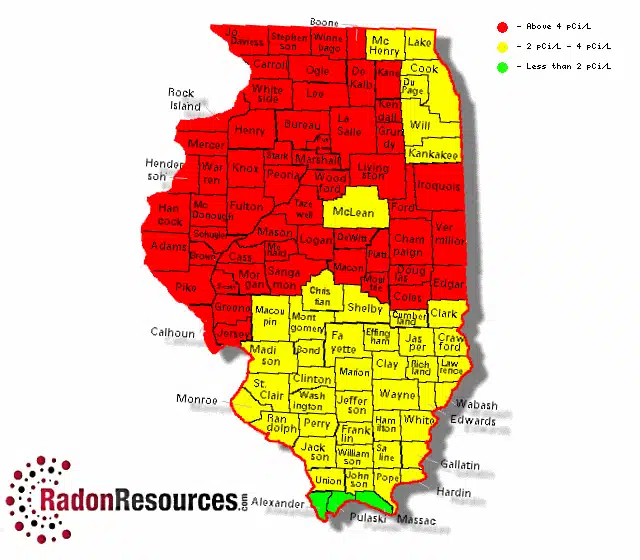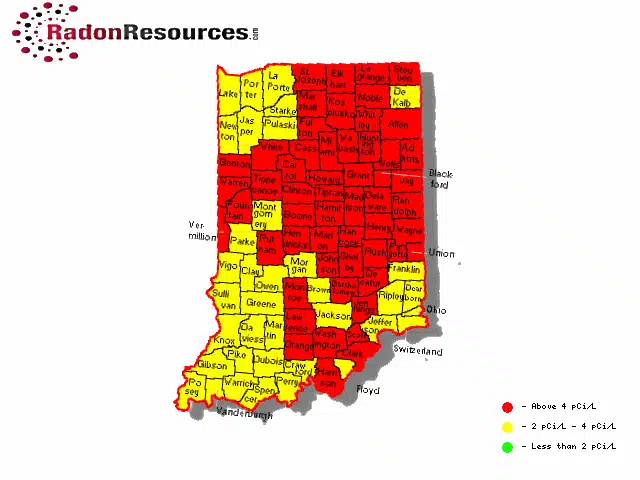Frequently Asked Questions
Click the + to the right of each questions to open the answer box.
Radon is a naturally occurring radioactive gas formed by the decay of uranium found in most soils and rock.
Most radon comes into a building from the soil, rock and or ground water below. Radon rises through the soil and gets trapped under the structure. The trapped gas builds up pressure, and since the air pressure in the house usually is lower, the gas is forced into the building through:
Cracks in floors and walls
Gaps in suspended floors
Openings around sump pumps and drains
Wall cavities
Construction joints
Gaps around service pipes or wires
Crawlspaces that open directly into the building
The water supply (Radon can affect bodies of water, specifically ground water)
Although most concern surrounds radon in family homes, radon also can be present in workplaces, schools, or hospitals.
In some instances Radon has been detected on granite counter tops used in kitchens and bathrooms.
Its presence is determined primarily by geology and has been found throughout Illinois and Indiana.
Radon is the leading cause of lung cancer in non-smokers.
The Surgeon General, EPA, Illinois Emergency Management and The Indian Department of Health recommend that all homes be tested for radon. Testing during the inspection period can give you valuable information about the home, whether remediation steps are warranted and peace of mind. A radon inspection is a small investment in your family's health.
Do-it-yourself test kits are available for testing your own home. However, Illinois requires that inspections for real estate transactions be performed by a Illinois Certified Radon Professional.
Elevated radon levels have been found in homes with basements, slab foundations and raised foundations.
Radon Testing takes 48 hours. We use state of the art electronic equipment which collects and analyzes the sample in real time. Results and a full written report are printed on site at the conclusion of your test.
The sellers may remain in the home during the test period. Dialogue with the sellers preceding the test is important. A copy of the test instructions will be forwarded to them during the scheduling process. We are available to answer any questions or concerns. Compliance verification steps are taken which include tamper seals on windows and non-essential doors and "close door" reminder notes on doors that will be used during the test period. Our equipment collects data on an hourly basis which will be analyzed for quality and consistency.
There are two common ways to determine radon levels in your home or business. Short term and long term air sampling.
Short term air sampling is relatively inexpensive and unobtrusive. It involves the placement of passive activated charcoal canisters within the lower levels of the habitable areas of the structure. These canisters do not make any noise during sample collection and are to remain undisturbed for 48 – 88 hours. During the sampling period the structure needs to remain in a closed condition. That is to say that all perimeter doors that lead outside and windows are to remain closed and ventilation fans should be turned off during sampling. Since radon levels often fluctuate—even on a day-to-day basis—a long-term test is the most reliable.
A long-term test is exactly that, a specialty device which will collect readings over a 90 day period. We are certified for radon measurement through the Illinois Emergency Management Agency and the State of Indiana Department of Health.
We have been performing radon inspections in the Chicagoland area and northwest Indiana area since 2015. We offer residential measurement services, with special expertise in the real estate transaction market.
If a properly performed test indicates an elevated level of radon in the home you wish to purchase, it is highly possible other homes in the same area will have elevated radon. So, if you like the house, consider taking a reasoned approach that will confirm levels and reduce the radon. Perhaps the best news about radon is that radon can be reduced, either before you buy the home, or after you buy it and move in.
Caution to buyer: If you want to insure that the radon mitigation system is installed to your standards you may consider overseeing the work yourself. A Seller would have incentive to look closer at cost than quality and in certain situations may make decisions that would differ from your decision.
The EPA recommends that you know what the indoor radon level is in any home you consider buying. Ask the seller for any and all previous radon test results. If the home has a radon-reduction system, ask the seller for any information they have about the system.
If you are thinking of buying a home, you may decide to accept an earlier test result from the seller or ask the seller for a new test to be conducted by a National Environmental Health Association (NEHA) qualified radon tester. Before you accept the sellers test, you should determine the following:
- The results of the previous testing;
- Who conducted the previous test; the homeowner, a radon mitigation professional, or some other person;
- Where in the home the previous test was taken, especially if you may plan to live in a lower level of the home. For example, the test may have been taken on the first floor. However, if you want to use the basement as living space, test there; and
- What, if any, structural changes, alterations, or changes in the heating, ventilation, and air conditioning (HVAC) system have been made to the house since the test was done. Such changes might affect radon levels.
If you accept the sellers test, make sure that the test followed the EPA and test manufacturers recommended protocol for deploying the test.
If the home has not yet been tested for radon. Make sure the radon test is done as soon as possible. Consider including provisions in the contract specifying:
- Where the test will be located (If your house has multiple foundation types or slab systems, we highly recommend testing not only in the lowest livable area of the house but also above each independent slab system and/or crawlspace within the house. Radon entry can take place in each of these areas independently thus mitigating lowest livable area may not lower the overall radon to safe levels);
- Who should conduct the test;
- What type of test to do;
- When to do the test;
- How the seller and the buyer will share the test results and test costs (if necessary); and
- When radon mitigation measures will be taken, and who will pay for them.
Make sure that the test followed the EPA and test manufacturers recommended protocol for deploying the test.
Need a Radon Test? Get started today!
Request your Commercial, Daycare/Preschool, or Home Radon Test Now!



